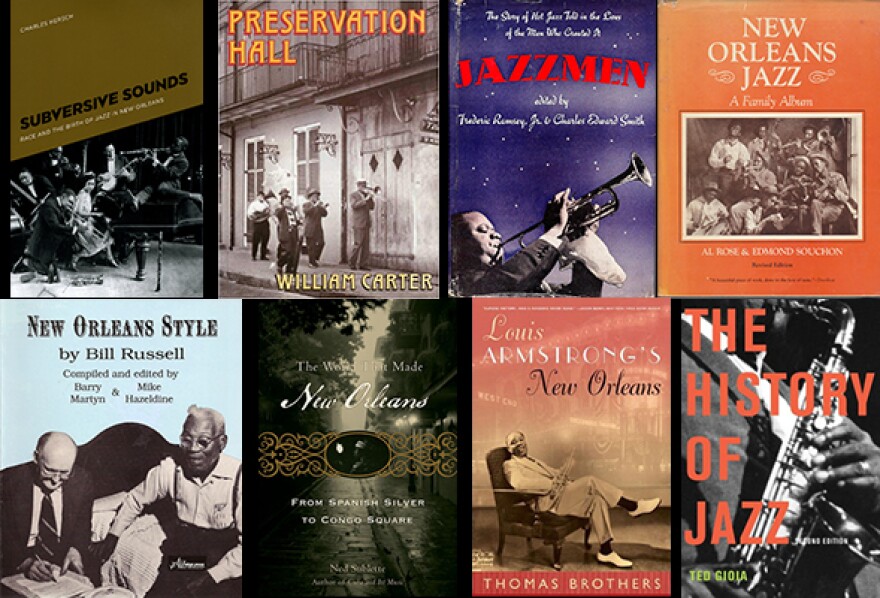- “The World that Made New Orleans: From Spanish Silver to Congo Square,” by Ned Sublette
- “Jazzmen,” edited by Frederic Ramsay, with key chapters by William Russell
- “New Orleans Jazz: A Family Album,” by Al Rose and Edmond Souchon
- “The History of Jazz ,” by Ted Gioia
- “Louis Armstrong's New Orleans,” by Thomas Brothers
- “Preservation Hall,” by William Carter
- “New Orleans Style by Bill Russell,” compiled and Edited by Barry Martyn & Mike Hazeldine
- “Subversive Sounds: Race and the Birth of Jazz in New Orleans,” by Charles Hersch
Transcripts
Susan Larson: Now when I showed you this list originally, you added a lot of wonderful books about jazz which I'm so grateful for and the first was Jazz Man, by Frederic Ramsay with some chapters by Bill Russell.
Jason Berry: Jazz Men is really the first it's kind of the urtext, you might say, about the idiom, Fred Ramsay and Bill Russell made a trip to New Iberia. I guess it was in 35 or 36, and they found Bunk Johnson, who had not been playing for many years. When you think about these guys journeying from New York and Pittsburgh and other places, because they heard the story that this old man, the living link to Armstrong. Anyway they sort of rehabilitated him and Russell eventually began recording him 1940s, but Jazz Men is an anthology and it was the first book to really explain how the music arose and Russell's chapters on New Orleans do stand the test of time he has a very insightful section on Congo Square and he talks about the importance of melody and how dancing was so central to the music of early jazz.
[“Jazz Me Blues” by Sidney Bechet]
Susan Larson: This is the dancing town.
Jason Berry: It's a dancing town.
Susan Larson: New Orleans jazz a family album by Al Rose and Edmond Souchon.
Jason Berry: It's an anthology. No, it's not an anthology; it's more like a dictionary with photographs, capsules, short profiles of various musicians interestingly near as many white Sicilian and Irish musicians in the book as African-Americans, wonderful photographs of early brass bands. It's a great reference text. Those guys work years on that book, painstakingly gathering information on all these musicians; so, to me it's a book that has to be given its due.
[“There’s a Two-Wing Tempe in the Sky” by Johnny Wiggs and His New Orleans Music]
Susan Larson: Then the history of jazz by Ted Gioia.
Jason Berry: Ted Gioia, The History of Jazz. What's so interesting about that book and a book that came out just within a few years, Louis Armstrong's New Orleans by Thomas Brothers, who teaches at Duke; those two books really put an emphasis on church music and the importance of the Jubilee dancing in these rural churches, as rural black folk made their way to the city from roughly the 1880s to about 1910. There were forty thousand African-Americans who came in from the plantation belt during that period and at the same time there was a flood of Sicilians coming in as well.
What's instructive about both of these books The History of Jazz by Ted Gioia and Louis Armstrong's New Orleans by Tom Brothers is the way in which each of these scholars delves into what those churches were like; the way the spirituals were ebbing and a more upbeat kind of religious singing was emerging.
[“God Rode in on a Windstorm” by Sister Sarah James and the Sanctified Six]
Jason Berry: (continues) Jazz is a fusion of the sacred and the profane. You had many of the same musicians who were playing the sawdust spattered floor of the Storyville cabarets at night and, by day, they're sitting in churches and playing dirges as the coffins are coming out. I think the religious dimension of the music got appropriate focus and weight from those two books.
Susan Larson: And Thomas Brothers book is so much fun to read. You feel like you’re hearing the music, seeing the city as it was then. It’s a very visual, rich book.
[“New Orleans Stomp” by Louis Armstrong]
Susan Larson: We've been talking with Jason Berry about the very best in New Orleans music books. Jason, thank you so much.
Jason Berry: Susan, it's always a pleasure, thank you.




